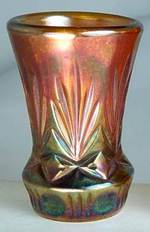Collectors Facts - Rising Comet and Grooves, probably Argentina
|
Shapes:
Decanter
Cordial / shot glass, 2.5 inch
|
Colours:
Marigold
Marigold; green
|
Sincere thanks to John Nielsen, Dolores Sage, Ed Kramer and Bob Grissom.
When Rising Comet and Grooves first surfaced, we considered whether it was from the same maker as a vase – Rising Comet – which as the name suggests, has a very similar design. At that time, it was thought that Rising Comet could be of Czech origin, maybe from Rindskopf.
When Rising Comet and Grooves first surfaced, we considered whether it was from the same maker as a vase – Rising Comet – which as the name suggests, has a very similar design. At that time, it was thought that Rising Comet could be of Czech origin, maybe from Rindskopf.
|
What has changed?
We had more evidence when, in 2003, a set of four Rising Comet and Grooves cordials in green Carnival was discovered - one is shown on the right, with a picture if its green base colour. Green Carnival is not known to have been made in Czechoslovakia, and circumstantial evidence was pointing more towards Argentina as the most likely origin of Rising Comet and Grooves. Now, thanks to a trio of dedicated collectors, we have another step towards confirmation: we have the extra strong evidence needed to make a firm case for South American production of the Rising Comet and Grooves decanter set. |
John Nielsen takes up the story:
"Bob Grissom read my article on Rising Comet and Grooves and realized he had seen a decanter with paper labels in Ed Kramer's house. You can see the picture in the centre below.
The label around the top says "Vino Natural Uraguaya". The main label (shown in close-up on the right, below) reads, "RESERVE 1920 CALIDAO SELECTA."
This seems to confirm your proposed origin in Argentine for this set - why would a wine producer in Uruguay send elsewhere for his bottles? In addition, it confirms that Rising Comet and Grooves was made in the classical period."
John's photo of the decanter and a close-up of the main label on it can be seen on the right - you can make out the date 1920.
"Bob Grissom read my article on Rising Comet and Grooves and realized he had seen a decanter with paper labels in Ed Kramer's house. You can see the picture in the centre below.
The label around the top says "Vino Natural Uraguaya". The main label (shown in close-up on the right, below) reads, "RESERVE 1920 CALIDAO SELECTA."
This seems to confirm your proposed origin in Argentine for this set - why would a wine producer in Uruguay send elsewhere for his bottles? In addition, it confirms that Rising Comet and Grooves was made in the classical period."
John's photo of the decanter and a close-up of the main label on it can be seen on the right - you can make out the date 1920.






